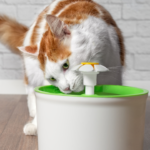
Can my cat eat fruits?
May 30, 2020
What is your cat trying to tell you?
June 20, 2020What is Your Cat’s Poop Telling You?

What’s normal? What’s not?
Because most indoor cats have a fairly steady diet, on a daily basis you’ll likely have very uniform-looking Tootsie Roll-shaped poops. Should you abruptly switch up that food, don’t be surprised if your cat’s stool gets runny or loose for a little while afterwards. A cat’s digestive tract can be a little sensitive to changes. If the loose stool persists, you should check with your veterinarian to rule out food sensitivities or other medical issues.
If you find your cat’s regular poop sometimes sticks to his tail end because of the way he positions himself when he uses the restroom, consider trimming his fur a little bit. It can save both of you grooming troubles and go far in keeping both your cat and your home cleaner.
Other things to look out for as you’re scooping include long spaghetti-like strands or what looks like bits of rice. These can be from parasites such as roundworms or tapeworm eggs. If you spot either of these, take a sample in a sealed bag or container to your veterinarian so they can diagnose the cause and prescribe the proper treatment.
You also may notice fur sometimes in your cat’s poop. Don’t worry. It’s normal and is simply a side effect from your kitty’s love of grooming.
Whisker-curling stench
If your cat’s stool is noticeably smellier than usual, dietary changes, bacteria, parasites, digestive disorders or more may be the cause. A visit to the veterinarian to determine what the cause is will make both your lives more pleasant. Be forewarned that sometimes it can be caused by a diet that’s high in protein. For many, such as cats who have been diagnosed with diabetes, a high protein diet is prescribed to keep things under control. If this is the case, you may just have to hold your nose, scoop and bear it.
Revenge poops
Cats sometimes defecate in inappropriate places, such as your shoes or bed. It may feel like they’re calculatedly mad at you; however, these behavioral issues are territorial ones. Don’t punish or scold as you’ll only make it worse. Instead, figure out what’s causing your cat’s emotional distress and work to eliminate it. You may also need to be proactive by keeping favorite pooping locations out of reach. Try shutting your bedroom door whenever possible and keeping targeted items like shoes safely stored in a closet.
Houston, we have a problem.
If you notice black, tarry or bloody poop or your cat stops going to the bathroom altogether (more than 48 hours) he may have an intestinal blockage or bleeding, kidney problems or other medical issue. Again, a veterinary trip needs to be your number one priority to see what’s going on.
What goes in must come out.
The best way to ensure your cat’s digestion stays as smooth and trouble-free as possible is to feed him high-quality nutrition on a regular basis. Cats are considered “obligate carnivores.” That means they must have protein from animal-based sources in their diet. However, they also need proper calcium, phosphorous and vitamin D (not available in a meat-only diet), in order to avoid a multitude of serious health concerns. That’s why it’s important to select a premium cat food made with high-quality protein, along with a balanced mix of vitamins, minerals and amino acids–such as taurine.
Feeding top-quality food but allowing your cat to snack on treats made with inferior ingredients can disrupt his digestion and result in some nasty litter box messes.
An added benefit to choosing a higher quality, nutrient-dense food is that you don’t have to feed as much food for your cat to get the nutrition he needs. Remember, less in means less out, which translates to less scooping for you!
Because cats are so concerned with the litter box, you usually can tell if they’re upset about something if they stop using their box correctly or at all. If your cat starts defecating in places other than his box, there are a myriad of reasons for this. First, take your cat and a feces sample (when possible) to your veterinarian to rule out any possible medical issues. Being constipated, in pain or discomfort can cause your cat to avoid the box as he associates it with unpleasantness.
Likewise, old age, trouble walking (including getting over the high lip of a litter box) or incontinence can dissuade him from even attempting to get there in time. Another common cause is having more than one cat in your house. The stress of being stalked while using the restroom can be too much for some cats. Provide each of your cats his own box, plus one extra, in separate places that are easy to access, and you’ll likely end this problem. You may need to do away with covered litter boxes as well as some cats panic at the thought of only one option in entering and exiting.
Source: petco.com






